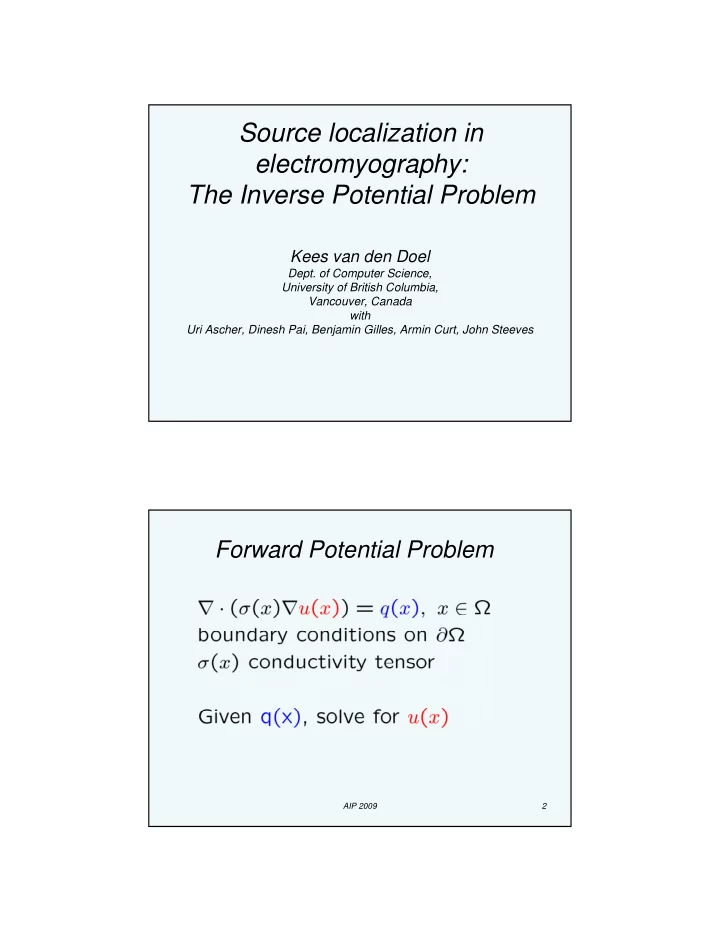

Source localization in electromyography: The Inverse Potential Problem Kees van den Doel Dept. of Computer Science, University of British Columbia, Vancouver, Canada with Uri Ascher, Dinesh Pai, Benjamin Gilles, Armin Curt, John Steeves Forward Potential Problem AIP 2009 2
Inverse Potential Problem AIP 2009 3 Non-uniqueness q1 q2 u u = Two charge distributions create same u(x) outside, if total charge is the same AIP 2009 4
Applications • Geophysics (u is gravitational pot.) • EEG, locate seizure focus in brain • Cardiology (find current sources in heart) • CMG, locate muscle activity – Novel work with D. Pai and U. Ascher AIP 2009 5 Tikhonov regularization AIP 2009 6
Computed Electromyography • Measure � n u(x) on skin • Reconstruct sources q(x) • First need a forward model: – Geometry • skin, fat, muscle, bone – Conductivity – FEM discretization AIP 2009 7 Getting Arm Geometry MRI Segmentation AIP 2009 8
Inversion Process AIP 2009 9 Properties of source q(x) q(x) made of (1000+) smeared tripoles running along muscle fibers AIP 2009 10
Choosing Representation • q = m, directly reconstruct source – Simple, resulting eq. easier to solve • q=m*D with D tripole basis functions • m expected to be “simpler” than q • In principle allows detection of depth – Use apparent size as cue • Effective outside sparse reconstruction context • Leads to numerical difficulties • Results in “numerical lab” favor D by a lot AIP 2009 11 Choosing Regularization R(m) • Decide on R(m) – L2 norm favors superficial sources – Weighted L2 norm with W s.t. interior sources are equally likely (W is computable with some effort) – ( � m) 2 favors smooth distribution • Good for bulk activity localizations • Leads to linear inverse problem • Can be weighted (less well motivated) – L1 norm favors superficial sources • Attempts sparse reconstruction (but is 2000 small?) • Non linear, hard to deal with time dependent data • Promising in EEG but many technical hurdles – L0 norm • Actual sources all of about equal strength • Should work best, but is untractable AIP 2009 12
Real-time is possible if we stay linear Extension Flexion AIP 2009 13 Numerics (linear case) AIP 2009 14
Numerics (L1 case) • l1_magic (Koh, Kim, Boyd, 2008) – Recast as convex quadratic problem with linear inequality constraints – Uses interior point method – Newton’s method step involves solving linear system which gets more and more ill- conditioned as problem gets bigger and as we get closer to the solution (in practice) – Works fine for 2D small problems AIP 2009 15 Numerical Experiments • Reconstructions inaccurate • Formal performance measures for inversion useless • Instead attempt a palette of synthetic problems and use taste and common sense measure • 3D FEM experiments hampered by numerical difficulties, so let’s work on a square grid in 2D AIP 2009 16
2D “muscle” (and the real thing) AIP 2009 17 Smooth, no D (=1) AIP 2009 18
L2, with D AIP 2009 19 Smooth, with D Smooth AIP 2009 20
L1 (with D) AIP 2009 21 Overall AIP 2009 22
L2 AIP 2009 23 L1 AIP 2009 24
Smooth AIP 2009 25 Overall AIP 2009 26
L1, no noise, tiny regularization AIP 2009 27 Smooth, no noise, tiny regularization AIP 2009 28
L1, smooth AIP 2009 29 Summary • Inverse potential problem has no unique solution • Hard to decide which regularization is best as inversion is inherently inaccurate • Numerical experiments seem to favour one particular formulation (Laplacian weighted 2-norm) • Tripole basis is necessary • Depth can be resolved theoretically but in practice only under unrealistically ideal conditions • Real-time inversion is possible (it’s linear) • In the large scale version I don’t know how to solve the linear equation • Inaccuracy of inversion remains an obstacle in medical applications (EEG,ECG,CMG) AIP 2009 30
Recommend
More recommend